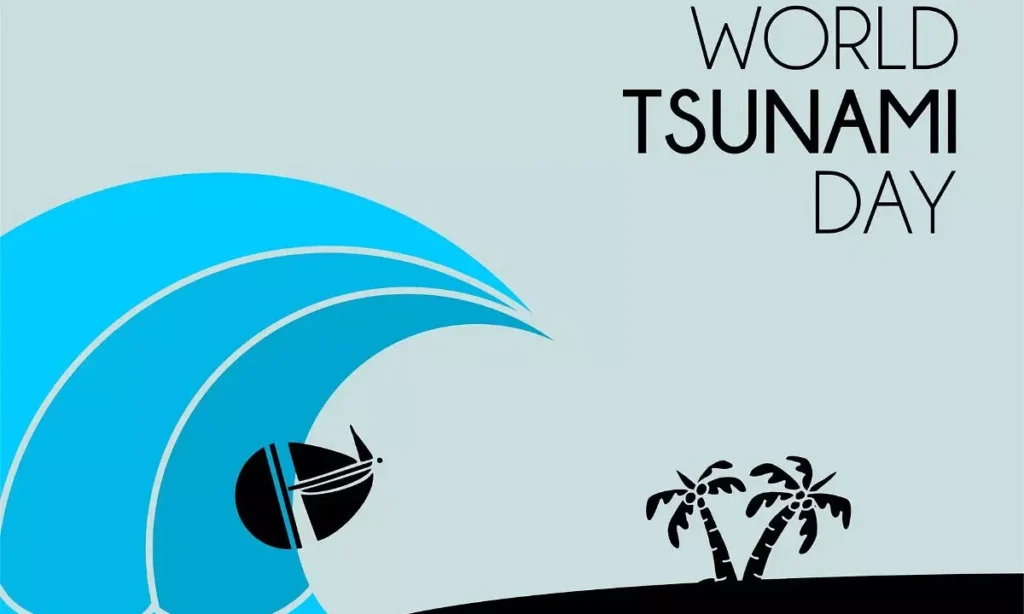Observed annually on November 5, World Tsunami Awareness Day is a global initiative led by the United Nations to promote awareness about the risks of tsunamis and the importance of preparedness. Established to save lives and reduce the devastating impact of these natural disasters, this day encourages individuals, communities, and nations to take proactive steps in building resilience against tsunamis.
Here’s everything you need to know about the significance, history, and objectives of World Tsunami Awareness Day, along with actionable insights to safeguard against these powerful forces of nature.

Origins and History
World Tsunami Awareness Day was established in 2015 by the United Nations General Assembly (UNGA) following a proposal from Japan, a country with a long history of battling tsunamis and a strong commitment to disaster risk reduction. The date, November 5, commemorates the actions of a Japanese farmer, Hamaguchi Goryo, who in 1854 saved countless lives by warning his village of an impending tsunami after an earthquake. His heroic act of setting fire to rice sheaves to alert others became a powerful symbol of early warning and preparedness.
Significance of the Day
Tsunamis, though rare, are among the most destructive natural disasters, capable of causing massive loss of life and property. Over the past 100 years, tsunamis have claimed over 260,000 lives, with an average death toll of 4,600 per disaster. The 2004 Indian Ocean tsunami alone resulted in over 230,000 fatalities across 14 countries, underscoring the importance of education, preparedness, and mitigation.
The objectives of World Tsunami Awareness Day include:
- Raising Awareness: Educating communities about tsunami risks and safety measures.
- Promoting Early Warning Systems: Highlighting the importance of timely alerts to minimize casualties.
- Encouraging Preparedness: Empowering individuals and governments to implement disaster risk reduction strategies.
- Global Cooperation: Fostering collaboration among nations to share best practices and resources for tsunami mitigation.
Understanding Tsunamis
Tsunamis are a series of large ocean waves triggered by underwater disturbances such as:
- Earthquakes (most common cause)
- Volcanic eruptions
- Landslides
- Meteorite impacts
Unlike regular sea waves, tsunamis can travel at speeds of up to 500-800 kilometers per hour in deep water and can rise to devastating heights when they approach coastal areas. Their sudden onset and immense energy make them particularly dangerous.
Challenges in Tsunami Preparedness
Despite advancements in technology and early warning systems, several challenges remain:
- Limited Awareness: Many communities, especially in low-income countries, lack knowledge about tsunami risks and safety protocols.
- Inadequate Infrastructure: Poorly designed buildings and unregulated coastal development increase vulnerability.
- Delayed Warnings: In some regions, communication gaps hinder the timely dissemination of alerts.
- Lack of Resources: Developing countries often struggle with funding and expertise to implement effective risk reduction measures.
How the Day is Observed
World Tsunami Awareness Day is marked by various activities and initiatives worldwide to educate and engage communities:
- Educational Campaigns: Schools, universities, and community organizations host workshops, simulations, and training sessions on tsunami preparedness.
- Public Drills: Coastal communities participate in evacuation drills to practice emergency responses.
- Awareness Drives: Governments and NGOs use social media, posters, and public events to spread information about tsunami risks and safety measures.
- Policy Discussions: Conferences and seminars focus on advancing international cooperation and improving disaster risk management policies.
- Resilience Building Projects: Efforts are undertaken to improve infrastructure, install warning systems, and promote sustainable coastal development.
UN Efforts and the Role of the Sendai Framework
The United Nations plays a pivotal role in promoting global tsunami preparedness through initiatives like the Sendai Framework for Disaster Risk Reduction (2015-2030). This framework outlines key priorities for action, including:
- Understanding Disaster Risk: Enhancing data collection and risk assessment.
- Strengthening Governance: Building institutional capacity for disaster management.
- Investing in Resilience: Allocating resources for early warning systems, resilient infrastructure, and public education.
- Enhancing Preparedness: Developing contingency plans and conducting regular drills.
World Tsunami Awareness Day aligns with the goals of the Sendai Framework, encouraging nations to integrate tsunami risk reduction into their development strategies.
What Can You Do to Stay Safe?
Tsunami preparedness is a shared responsibility. Here are some steps individuals and communities can take:
- Know the Signs: Be aware of natural tsunami warnings, such as strong earthquakes, unusual ocean behavior, or loud roaring sounds from the sea.
- Stay Informed: Follow local alerts and warnings issued by authorities or tsunami warning centers.
- Create an Emergency Plan: Identify safe evacuation routes and assemble a disaster kit with essentials like water, food, first aid supplies, and communication tools.
- Participate in Drills: Engage in community drills to understand evacuation procedures and safety measures.
- Support Awareness Campaigns: Share information and encourage others to learn about tsunami risks and preparedness.
Global Success Stories
World Tsunami Awareness Day has inspired numerous initiatives and success stories:
- Indonesia’s Tsunami Warning System: After the 2004 Indian Ocean tsunami, Indonesia established a sophisticated early warning system, significantly reducing response times.
- Japan’s Disaster Preparedness Culture: Japan’s emphasis on education, drills, and infrastructure has made it a global leader in disaster resilience.
- Pacific Tsunami Warning Center: This international network monitors seismic activity and issues timely alerts to coastal regions worldwide.
Looking Ahead: Building Resilience
As urbanization and climate change increase the vulnerability of coastal areas, the importance of tsunami awareness and preparedness continues to grow. Collaborative efforts among governments, NGOs, and communities are essential to mitigate risks and save lives. Investing in education, infrastructure, and technology will be crucial in building resilience against future tsunamis.
Conclusion
World Tsunami Awareness Day is a vital reminder of the power of preparedness and the importance of collective action in reducing the impact of tsunamis. By fostering awareness, promoting early warning systems, and encouraging resilience-building measures, this observance empowers communities to safeguard lives and livelihoods. Let us use this day to honor the victims of past tsunamis and commit to a future where preparedness and resilience are the cornerstones of coastal safety. Together, we can reduce the risks and ensure a safer world for generations to come.

